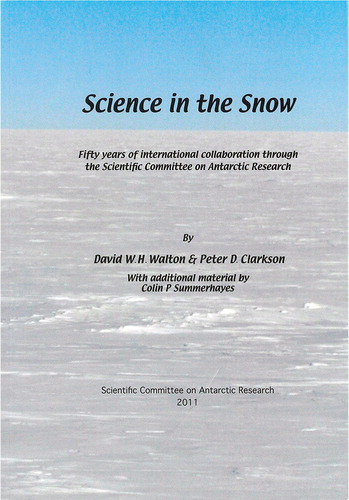Review of Science in the snow: fifty years of international collaboration through the Scientific Committee on Antarctic Research, by David W.H. Walton & Peter D. Clarkson (2011). Cambridge: Scientific Committee on Antarctic Research. 258 pp. ISBN 978-0-948277-25-2.
D. Walton and P. Clarkson present a history of the last 50 years of international collaborations stimulated by the presence and flexibility inherent in the Scientific Committee on Antarctic Research (SCAR) in their new book Science in the snow. As aptly portrayed in the acknowledgements that precede the book, SCAR has been both an important umbrella for drawing attention to the Antarctic and a virtual and real (meeting rooms to pubs) venue for Antarctic scientists to discuss their scientific findings, their experiences, and their dreams for understanding a place that—with the exception of the impact of iconic expeditions of the early explorers—was barely on the world's collective mind until about 50 years ago.
When SCAR emerged as an entity in the late 1950s the Antarctic was believed to be no more than a remote ice-covered continent—almost an anomaly at the end of the Earth. The idea that Antarctica and its ecosystem might be impacted by much of anything happening in the rest of the planet was not part of the logic of the time. As researchers started to push into their disciplinary investigations, they first reported evidence suggesting an uncomplex environment, dominated, of course, by cold, and a relatively timeless, unchanging land–ice-scape. Monitoring of the Antarctic environment started during the International Geophysical Year (1957–58) and forays throughout the continent have since convinced all of us working in the Antarctic that it is a complex region with great diversity and far more fragile than ever expected. SCAR has been the sounding board for all of the evolution in scientific thinking surrounding Antarctica. It represents Antarctica's emerging significance and role in global scientific discovery and international collaboration. SCAR also acts as the springboard for advancement of multi-disciplinary and multi-national research in Antarctica and acts as a model for similar activities worldwide. The evolution of SCAR's role in the global scientific and political arena is neatly and in some places amusingly set out chronologically in the book's chapters with a selection of photographs from by-gone meetings and field research.
Just as our collective understanding of the Antarctic has matured, so too has SCAR as an organization—a representative for Antarctica and a home for Antarctic science planning, reporting and discussions—with great implications for Antarctic science. Science in the snow captures the unique emergence of Antarctic science planning through the highly dynamic collection of its members and activities. SCAR is now more important than ever as the primary international voice for Antarctica and Science in the snow will help to mark SCAR's role in this process.
